March 22, 2010 report
Quantum dots could boost performance of mobile phone cameras

(PhysOrg.com) -- As it's becoming more and more difficult for silicon alone to improve the sensors used in today's digital cameras, a new material may be emerging from physics labs to provide a large performance boost for digital cameras. QuantumFilm, which is made of quantum dots, could offer four times better performance and twice the dynamic range of existing silicon sensors, claim its developers at Menlo, Calif.-based start-up company InVisage.
The main advantage of using quantum dots is that, compared to silicon, these tiny semiconductors are much more light-sensitive, meaning they can turn more of the incoming light into an electric charge than silicon sensors. While silicon-based image sensors today capture about 25% of incoming light, silicon sensors coated with QuantumFilm can capture 90-95% of the light, enabling better quality pictures, especially in difficult lighting conditions.
According to InVisage, quantum-dot-based camera sensors can achieve the same performance as today’s digital cameras in a much smaller size. This advantage should be particularly beneficial for high-end mobile phones, giving them the ability to capture stunning images with a quality comparable to today’s digital cameras.
As InVisage President and CEO Jess Lee explained, QuantumFilm could transform the current three-megapixel camera found in the Apple iPhone into a 12-megapixel camera that works better in varying light conditions. He also said that the quantum-dot-based sensors would not be more expensive than current sensors.
Overall, the problem with silicon-based sensors is two-fold: not only does silicon turn only half of the incident light into electric charge, but metal circuits also block part of the light, reducing the overall efficiency to 25%.
"It is becoming increasingly difficult and expensive to develop next-generation image sensors using silicon; essentially, silicon has hit a wall," said Lee. "The fundamental problem is that silicon cannot capture light efficiently, but until now it has been the only option."
InVisage’s solution to these problems - QuantumFilm - was developed by InVisage CTO Ted Sargent, who is also a professor at the University of Toronto. Sargent showed that, by adding a coat of QuantumFilm to the silicon, he could create sensors that can achieve three times’ greater efficiency than silicon alone. In addition, the design enables the metal circuits to be placed underneath the quantum film, where they don’t block any light.
Although quantum dots are commercially produced by other manufacturers, they have never been used for image sensors before. More typical applications include solar cells, displays, and identification markers.
InVisage says it will have samples ready for phone manufacturers by the end of the year and the sensors could be in mobile phones by mid next-year. Other applications could include automotive and security cameras, as well as military applications. The technology should be easily integrated into existing semiconductor manufacturing methods.
QuantumFilm will be demonstrated for the first time this week at DEMO Spring 2010 in Palm Desert, Calif., and at Image Sensors Europe 2010 in London.
More information:
www.invisageinc.com
via: InVisage press release
© 2010 PhysOrg.com

















